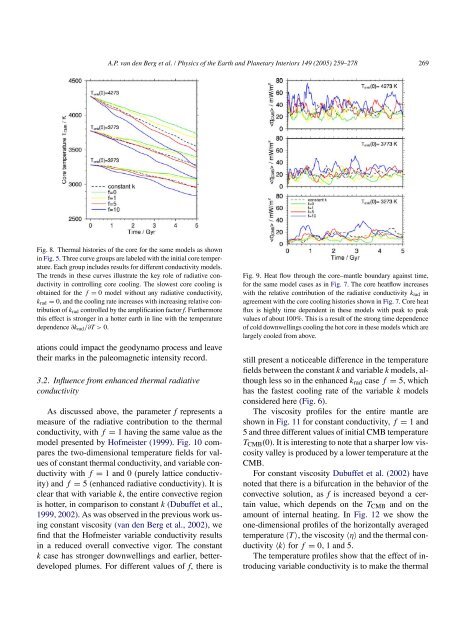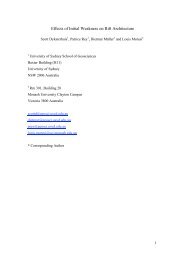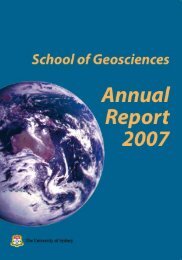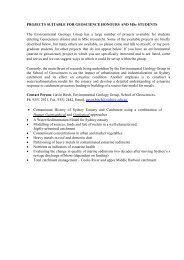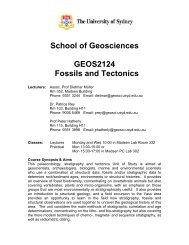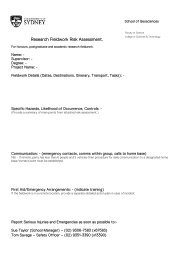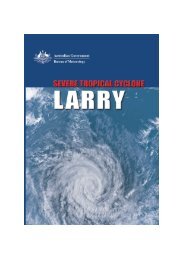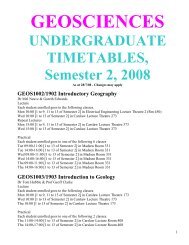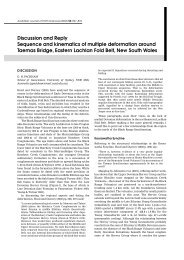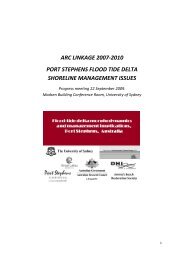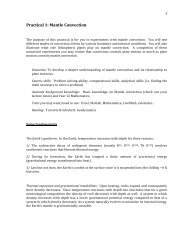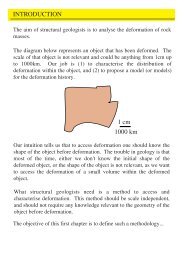van den Berg et al., 2005, Earth Planetary Science Letters.
van den Berg et al., 2005, Earth Planetary Science Letters.
van den Berg et al., 2005, Earth Planetary Science Letters.
You also want an ePaper? Increase the reach of your titles
YUMPU automatically turns print PDFs into web optimized ePapers that Google loves.
A.P. <strong>van</strong> <strong>den</strong> <strong>Berg</strong> <strong>et</strong> <strong>al</strong>. / Physics of the <strong>Earth</strong> and Plan<strong>et</strong>ary Interiors 149 (<strong>2005</strong>) 259–278 269<br />
Fig. 8. Therm<strong>al</strong> histories of the core for the same models as shown<br />
in Fig. 5. Three curve groups are labeled with the initi<strong>al</strong> core temperature.<br />
Each group includes results for different conductivity models.<br />
The trends in these curves illustrate the key role of radiative conductivity<br />
in controlling core cooling. The slowest core cooling is<br />
obtained for the f = 0 model without any radiative conductivity,<br />
k rad = 0, and the cooling rate increases with increasing relative contribution<br />
of k rad controlled by the amplification factor f. Furthermore<br />
this effect is stronger in a hotter earth in line with the temperature<br />
depen<strong>den</strong>ce ∂k rad /∂T > 0.<br />
ations could impact the geodynamo process and leave<br />
their marks in the p<strong>al</strong>eomagn<strong>et</strong>ic intensity record.<br />
3.2. Influence from enhanced therm<strong>al</strong> radiative<br />
conductivity<br />
As discussed above, the param<strong>et</strong>er f represents a<br />
measure of the radiative contribution to the therm<strong>al</strong><br />
conductivity, with f = 1 having the same v<strong>al</strong>ue as the<br />
model presented by Hofmeister (1999). Fig. 10 compares<br />
the two-dimension<strong>al</strong> temperature fields for v<strong>al</strong>ues<br />
of constant therm<strong>al</strong> conductivity, and variable conductivity<br />
with f = 1 and 0 (purely lattice conductivity)<br />
and f = 5 (enhanced radiative conductivity). It is<br />
clear that with variable k, the entire convective region<br />
is hotter, in comparison to constant k (Dubuff<strong>et</strong> <strong>et</strong> <strong>al</strong>.,<br />
1999, 2002). As was observed in the previous work using<br />
constant viscosity (<strong>van</strong> <strong>den</strong> <strong>Berg</strong> <strong>et</strong> <strong>al</strong>., 2002), we<br />
find that the Hofmeister variable conductivity results<br />
in a reduced over<strong>al</strong>l convective vigor. The constant<br />
k case has stronger downwellings and earlier, b<strong>et</strong>terdeveloped<br />
plumes. For different v<strong>al</strong>ues of f, there is<br />
Fig. 9. Heat flow through the core–mantle boundary against time,<br />
for the same model cases as in Fig. 7. The core heatflow increases<br />
with the relative contribution of the radiative conductivity k rad in<br />
agreement with the core cooling histories shown in Fig. 7. Core heat<br />
flux is highly time depen<strong>den</strong>t in these models with peak to peak<br />
v<strong>al</strong>ues of about 100%. This is a result of the strong time depen<strong>den</strong>ce<br />
of cold downwellings cooling the hot core in these models which are<br />
largely cooled from above.<br />
still present a noticeable difference in the temperature<br />
fields b<strong>et</strong>ween the constant k and variable k models, <strong>al</strong>though<br />
less so in the enhanced k rad case f = 5, which<br />
has the fastest cooling rate of the variable k models<br />
considered here (Fig. 6).<br />
The viscosity profiles for the entire mantle are<br />
shown in Fig. 11 for constant conductivity, f = 1 and<br />
5 and three different v<strong>al</strong>ues of initi<strong>al</strong> CMB temperature<br />
T CMB (0). It is interesting to note that a sharper low viscosity<br />
v<strong>al</strong>ley is produced by a lower temperature at the<br />
CMB.<br />
For constant viscosity Dubuff<strong>et</strong> <strong>et</strong> <strong>al</strong>. (2002) have<br />
noted that there is a bifurcation in the behavior of the<br />
convective solution, as f is increased beyond a certain<br />
v<strong>al</strong>ue, which depends on the T CMB and on the<br />
amount of intern<strong>al</strong> heating. In Fig. 12 we show the<br />
one-dimension<strong>al</strong> profiles of the horizont<strong>al</strong>ly averaged<br />
temperature 〈T 〉, the viscosity 〈η〉 and the therm<strong>al</strong> conductivity<br />
〈k〉 for f = 0, 1 and 5.<br />
The temperature profiles show that the effect of introducing<br />
variable conductivity is to make the therm<strong>al</strong>


